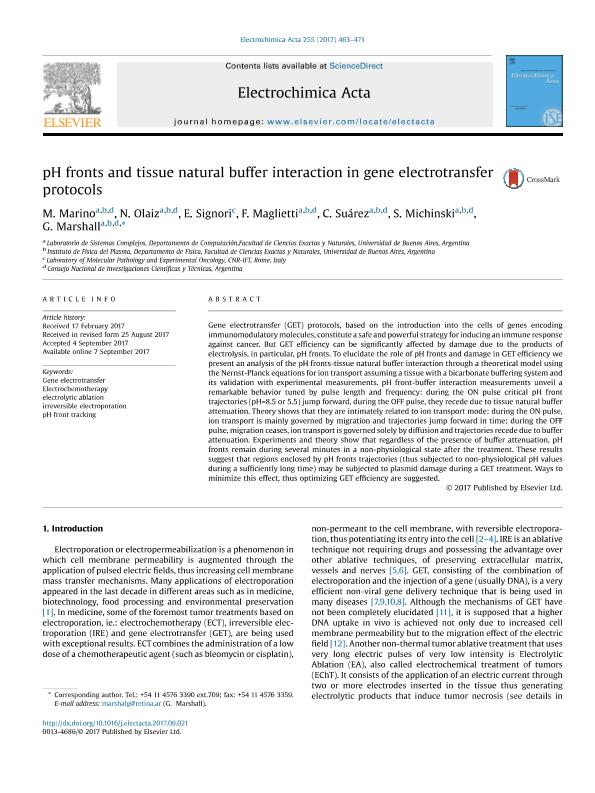Artículo
pH fronts and tissue natural buffer interaction in gene electrotransfer protocols
Marino, M; Olaiz, Nahuel Manuel ; Signori, Emanuela; Maglietti, Felipe Horacio
; Signori, Emanuela; Maglietti, Felipe Horacio ; Suárez, Cecilia Ana
; Suárez, Cecilia Ana ; Michinski, Sebastián Diego
; Michinski, Sebastián Diego ; Marshall, Guillermo Ricardo
; Marshall, Guillermo Ricardo
 ; Signori, Emanuela; Maglietti, Felipe Horacio
; Signori, Emanuela; Maglietti, Felipe Horacio ; Suárez, Cecilia Ana
; Suárez, Cecilia Ana ; Michinski, Sebastián Diego
; Michinski, Sebastián Diego ; Marshall, Guillermo Ricardo
; Marshall, Guillermo Ricardo
Fecha de publicación:
11/2017
Editorial:
Pergamon-Elsevier Science Ltd
Revista:
Electrochimica Acta
ISSN:
0013-4686
Idioma:
Inglés
Tipo de recurso:
Artículo publicado
Clasificación temática:
Resumen
Gene electrotransfer (GET) protocols, based on the introduction into the cells of genes encoding immunomodulatory molecules, constitute a safe and powerful strategy for inducing an immune response against cancer. But GET efficiency can be significantly affected by damage due to the products of electrolysis, in particular, pH fronts. To elucidate the role of pH fronts and damage in GET efficiency we present an analysis of the pH fronts-tissue natural buffer interaction through a theoretical model using the Nernst-Planck equations for ion transport assuming a tissue with a bicarbonate buffering system and its validation with experimental measurements. pH front-buffer interaction measurements unveil a remarkable behavior tuned by pulse length and frequency: during the ON pulse critical pH front trajectories (pH=8.5 or 5.5) jump forward, during the OFF pulse, they recede due to tissue natural buffer attenuation. Theory shows that they are intimately related to ion transport mode: during the ON pulse, ion transport is mainly governed by migration and trajectories jump forward in time; during the OFF pulse, migration ceases, ion transport is governed solely by diffusion and trajectories recede due to buffer attenuation. Experiments and theory show that regardless of the presence of buffer attenuation, pH fronts remain during several minutes in a non-physiological state after the treatment. These results suggest that regions enclosed by pH fronts trajectories (thus subjected to non-physiological pH values during a sufficiently long time) may be subjected to plasmid damage during a GET treatment. Ways to minimize this effect, thus optimizing GET efficiency are suggested.
Archivos asociados
Licencia
Identificadores
Colecciones
Articulos(INFINA)
Articulos de INST.DE FISICA DEL PLASMA
Articulos de INST.DE FISICA DEL PLASMA
Citación
Marino, M; Olaiz, Nahuel Manuel; Signori, Emanuela; Maglietti, Felipe Horacio; Suárez, Cecilia Ana; et al.; pH fronts and tissue natural buffer interaction in gene electrotransfer protocols; Pergamon-Elsevier Science Ltd; Electrochimica Acta; 255; 11-2017; 463-471
Compartir
Altmétricas



